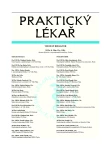Addictive drugs in primary care
Authors:
J. Štolfa 1; J. Hobstová 2,3; V. Bencko 4
Authors‘ workplace:
IPVZ Praha, Katedra všeobecného lékařství
Univerzita Karlova v Praze, 2. LF
Výukové pracoviště praktického lékařství
Vedoucí lékař: MUDr. Josef Štolfa
1; FN Motol, Praha
Infekční oddělení a Infekční centrum pro drogově závislé
Primářka: MUDr. Jiřina Hobstová, CSc.
2; Univerzita Karlova v Praze, 1. LF
3. Infekční klinika FN Na Bulovce
Přednosta: doc. MUDr. Michal Holub, Ph. D.
3; Univerzita Karlova v Praze, 1. LF
Ústav hygieny a epidemiologie
Přednosta: Prof. MUDr. Vladimír Bencko, DrSc.
4
Published in:
Prakt. Lék. 2009; 89(3): 113-120
Category:
Reviews
Overview
Addictive disorders are among the most common chronic diseases faced by physicians, and yet they are among the least understood by the average clinician. Most medical schools provide only 1 or 2 lectures on addiction throughout the 6-year course, and information provided by teachers at the bedside is often wrong or misleading. It is common for physicians to assume that evidence of tolerance and physical dependence (withdrawal) implies the presence of addiction. In reality, many drugs produce adaptive changes in the body that result in the appearance of tolerance with rebound symptoms (withdrawal) when the drug is stopped abruptly. This chapter is focused on explanation of basic knowledge and aspects concerning main representatives of each group of drugs.
Keywords:
addictive drugs, drug addiction, marihuana, stimulans, opioids, general practitioner.
Sources
1. Ashton, C.H. The fatal consequence of cannabis abuse. Br. J. Psychiatry 2001, 178, p. 101-106.
2. Bolla, K., Brown, K., Eldreth D. et al. The long term side effects of cannabis use. Neurology 2002, 59, p. 1337-1343.
3. Marijuana abuse. NIDA Research Report series 2005, p. 1-8 [on-line]. Dostupné na http://www.drugabuse.gov/PDF/RRMarijuana.pdf
4. Drábková, J. Novodobá problematika drog a nečekaná užití léků v medicíně jednotlivců i většího počtu postižených. Referátový výběr z anesteziologie, resuscitace a intenzivní medicíny, suplementum 2/2003, s. 1-2.
5. Geberlich, S., Sydney, S., Braun, B.L. et al. The reaction time after cannabis intoxication, Ann. Epidemiol. 2003, 13, p. 230-237.
6. Hall, W., Solowij, N. Adverse effects of cannabis. Lancet 1998, 352, p. 1611-1616.
7. Hnilicová, H., Bencko, V. Kvalita života – vymezení pojmu a jeho význam pro medicínu a zdravotnictví. Prakt. lék. 2005, 85, 11, s. 656-660.
8. Hobstová, J., Vitouš, A. Infekční komplikace uživatelů drog v ČR. Čas. lék. čes. 2007, 2, s. 137-143.
9. Kalina, K. Halucinogenní látky. Drogy a drogové závislosti. Praha: Národní monitorovací středisko pro drogy a drogové závislosti. Úřad vlády ČR 2003.
10. Miovský, M., Miovská, L. Aktuální situace v užívání NL v ČR a založení nového oboru adiktologie. Prakt. lék. 2006, 86, 3, s. 138-143.
11. Miovská, L., Miovský, M. Paměťové funkce u uživatelů konopných drog. Adiktologie 2004, 4, s. 545-552.
12. Miovský, M., Miovská, L., Mravčík, V. Aktuální přehled stavu užívání nelegálních drog v ČR. Čas. lék. čes. 2004, 11, s. 723-730.
13. Nešpor, K. Alkohol a jiné návykové látky u dětí, prevence v rodině. Čas. lék. čes. 2004, 8, s. 561-564.
14. Nešpor, K., Csémy, L., Zima, T. Škodlivé účinky marihuany s odstupem několika let. Čas. lék. čes. 2004, 7, s. 490-491.
15. Popov, P. Problematika návykových látek. Kurz ČLK 2004.
16. Straňák, M. Závislost u matek a těhotných. Kurz ČLK, 2004.
17. Tashkin, D., Baldwin, P., Sarafian, C. et al. Respiratory and immunologic consequences of marijuana smoking. J. Clin. Pharmacol. 2002, 42, 11 Suppl, p. 71-81.
18. Višňovský, P., Bečková, I. Farmakologie drogových závislostí. Halucinogeny. Praha: Karolinum 1999.
19. Výroční zpráva ČR – 2007. Praha: Hygienická stanice hl.m.Prahy, Centrální pracoviště drogové epidemiologie, 2008, s. 38.
20. Zeman, P. Chronické hepatitidy a jejich zdravotně sociální problematika v ordinaci PL. Prakt. lék. 2006, 86, 9, s. 517-519.
Labels
General practitioner for children and adolescents General practitioner for adultsArticle was published in
General Practitioner

2009 Issue 3
- Hope Awakens with Early Diagnosis of Parkinson's Disease Based on Skin Odor
- Memantine Eases Daily Life for Patients and Caregivers
- Memantine in Dementia Therapy – Current Findings and Possible Future Applications
- Metamizole vs. Tramadol in Postoperative Analgesia
- What Effect Can Be Expected from Limosilactobacillus reuteri in Mucositis and Peri-Implantitis?
Most read in this issue
- Corticosteroids as a treatment of rheumatoid arthritis
- A new anti-obesity drug on the horizon?
- Addictive drugs in primary care
- Infections imported from exotic countries
